Contributor: Sean Mathews (Strategy Consultant, RBC Ventures)
Over the years, starting from when I first arrived in Canada, I’ve met many newcomers and learnt about the challenges encountered in the job search process and the Canadian workplace. One that has not been discussed, and turns up again and again is the challenge of the questions we don’t ask, either because we feel uncomfortable, or don’t know how to broach the subject. Having moved countries twice, I believe I am fairly well positioned to pen my answers to some questions that are often left unasked and I would welcome any additions and discussions.
Why does it take longer to land a job in Canada?
Simply put, the length of the job hunt is attributable to a longer hiring process on average. You could have many rounds of interview before you are selected. For an average Canadian the stipulated time it takes to find a job is between 16 to 20 weeks. There is a theory (not scientific) that states for every $10,000 in salary expectation the job search would take a month. By that theory, a $60,000 job would take six months.
Newcomers need to work a bit harder because they lack the network and Canadian perspective. For a newcomer, this timeline is understandably frustrating, but the good news is that of late, I have seen newcomers arrive a lot more prepared and land good jobs in a few months.
Being prepared could significantly increase your success rate and possibly reduce the time it takes to land a job. Read about preparing pre-landing, winning LinkedIn strategies and how to master your interview.
Why am I sometimes not understood, even though I speak fluent English?
Canadians are very careful not to be rude and hurt a newcomer’s feelings, so the reason you may not being understood could be the speed at which we speak or the emphasis in pronunciation of particular words. This depends upon where you come from, and how recently.
We also use certain common phrases from back home, which we assume to be part of English universally, but are not used in this part of the world. For example words like ‘shifted’, used to say that we moved (homes) or ‘the same’, used to express doing the task or action referred to in the previous sentence, are not commonly used.
Furthermore, due to the stress of a new environment or an interview scenario inadvertently increases the pace of speech. The simple solution is to consciously slow down, focus on clear pronunciation and use short sentences. Listen to your Canadian counterparts for pacing.
Why do I find my audience losing interest in what I have to say?
Many newcomers find it difficult to get the balance right between brevity (being to the point) and detail (how much information to include). As a newcomer to Canada with years of experience, you want to impress the other person with all of your achievements.
Often though, in trying to communicate too many things, you could end up losing your audience. Canadians genuinely want to hear your story, but in business situations particularly, clarity and brevity are key.
A way to navigate the brevity challenge is by highlighting the volume of what you worked on, say, many projects over number of years but elaborate on those that are most relevant to your audience. Choose the top three projects that best communicate the essence of what you do and who you are. Remember, less is more.
Why was I not appreciated for a hack I thought was rather smart?
In India, the culture is to find smart hacks that circumvent long processes in order to get the job done quicker. Canada on the other hand is a process-oriented culture that does not appreciate hacks. Canadian employers are interested in understanding how you championed a process, tool creation or any solution that is collaborative and serves the team. This does not mean you should never talk about those smart hacks, but you should invest a bit of thought in how you could present those hacks in a manner that Canadian employers see them as innovative initiatives.
About the Author:
Sean is a brand and communications strategist with over two decades of experience working with clients in Airlines, Automobiles, Alcoholic Beverages, Banking, Confectionaries, Consumer Electronics, and Quick Service Restaurants across geographies. In his current role he supports marketing and campaign development for Arrive and other ventures. Sean moved to Canada four years ago and shares his experiences with newcomers to guide them.




